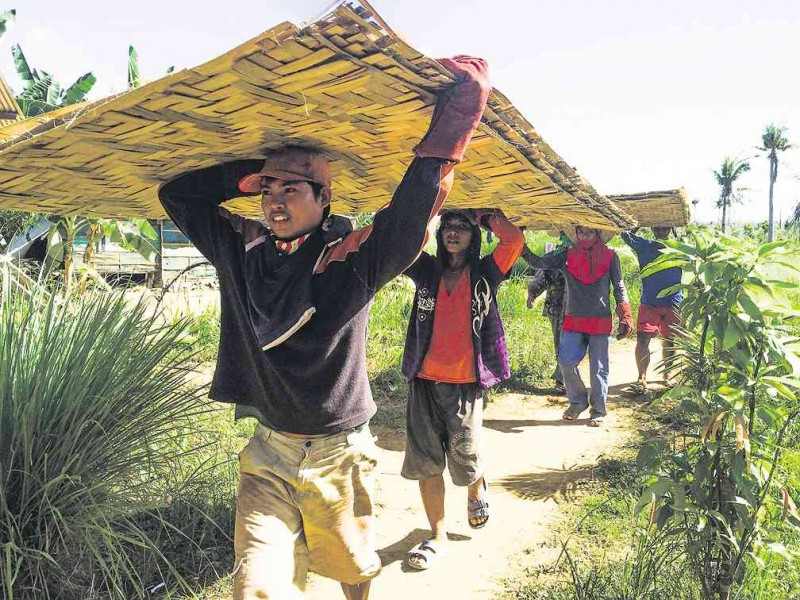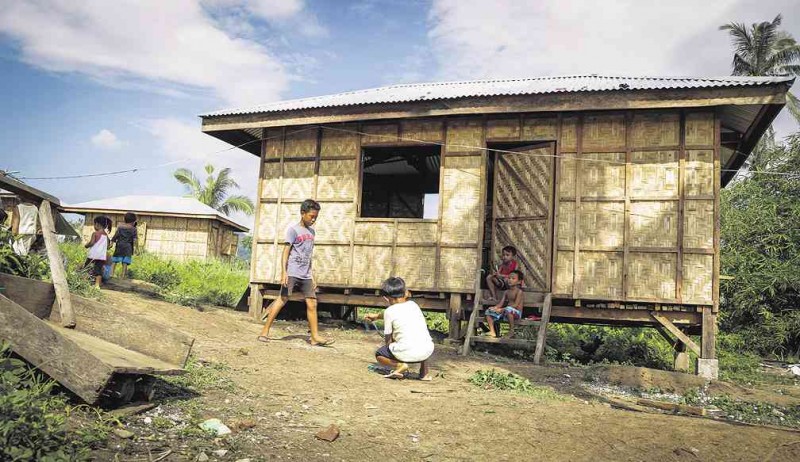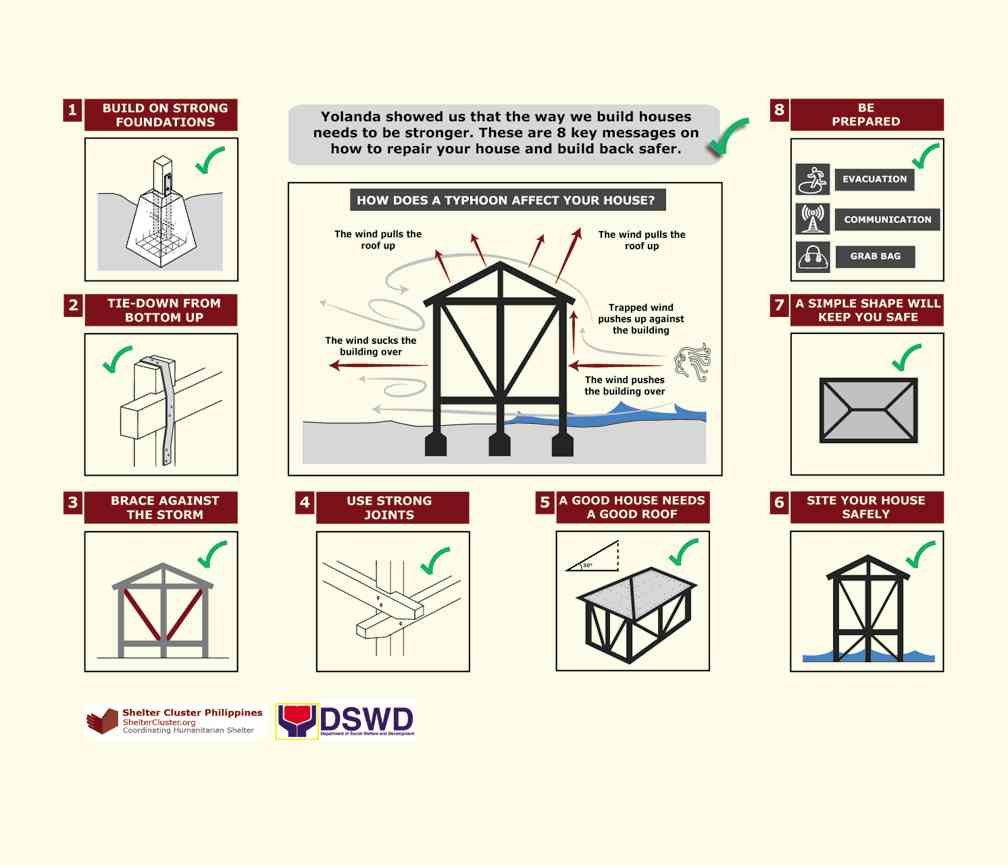Stories of struggle and hope
Sitio 22, a community of 21 families affected by Supertyphoon “Yolanda” (international name: Haiyan) in Marabut, Samar, is a rough two-hour drive from the main highway.
As in many places, the houses in this community were badly damaged by the 300-kilometer winds of Yolanda, the strongest typhoon in recorded history to make landfall.
Around 6,300 people died and 28,000 were injured from the typhoon that also displaced 4.1 million people in central Philippines. At least 1.14 million homes were damaged or destroyed.
Article continues after this advertisementA year after, there are hardly traces of this devastation in Sitio 22. One will see scenes such as boys playing basketball, two carabaos bathing at a small pond, carpenters busy hammering, sari-sari stores thriving, and children and women while away their afternoons in new houses made of coconut lumber and sawali.

WORKERS in Quinapondan in Eastern Samar haul shelter materials as part of the cash-for-work activities of the ICRC and the Philippine Red Cross. ©ICRC/J. Edep
“I think we are OK now. But our life is still not the same as before the typhoon,” said Edmundo Pabello, a 46-year-old farmer and resident of Sitio 22, in Waray.
Pabello lost his home and crops in the wake of the typhoon. Days after the catastrophe, he said: “Our houses here were badly damaged. We didn’t have food right after the typhoon. It was really difficult for several days.”
Article continues after this advertisementCarpentry, resilient homes
Given the destruction, Pabello saw carpentry as a means to make a living while farming was not yet an option. He and his son were hired as carpenters by the Red Cross to help build storm-resilient houses.
“We learned a lot from the typhoon. Our houses were not resilient enough so they were destroyed,” he said.
As a Red Cross carpenter, Pabello was trained on good construction principles for storm-resilient shelters. In the end, he also built his own house with the support of the Red Cross. With proper maintenance, these shelters are expected to last about 10 years.
“I have now made sure that our new house is strong enough. I even bought additional nails to make it sturdy,” he said.
3-year recovery plan
Since Yolanda’s unprecedented devastation, the International Red Cross and Red Crescent Movement (RCRC Movement) has been on the ground supporting hundreds of communities across the affected islands of Leyte, Samar, Panay, Cebu and Palawan.
Supporting the Philippine Red Cross (PRC) in its 2013-2016 recovery plan to deliver a wide range of assistance to 500,000 worst-affected people are the International Committee of the Red Cross (ICRC), the International Federation of the Red Cross and Red Crescent, and 136 Red Cross and Red Crescent national societies from around the world.
“The good cooperation among Movement partners has allowed us to be more efficient and more widespread in our support for affected areas,” said Pascal Mauchle, head of the ICRC delegation to the Philippines.
One year on, the RCRC Movement has built over 6,000 shelters across the affected island groups.
In Samar, one of the poorest islands in the country that is also partly affected by armed violence, the ICRC and the PRC have completed 4,063 storm-resilient shelters out of its target 4,500 by end December—a happier Christmas for these most vulnerable families.
Training
Training sessions on good construction principles were also conducted for over 560 carpenters to ensure that the shelters can withstand around 220 kph winds, thanks to additional bracing and hurricane straps.
“I learned a lot from the training. I now know how to make sure that a house is durable, like bracing for this type of house,” said Apolinar Gagatiga, a 54-year-old carpenter in Guiuan, the area where Yolanda made its first landfall.
Given the devastation in Guiuan, a town beside the sea, its recovery has been quite significant one year on due to the massive support that poured in. While there are ruined coconut trees and unrepaired houses here and there, Guiuan recently celebrated its fiesta—toasting to the life that has forever changed.
In the aftermath of Yolanda, Gagatiga’s wife and four children endured living for several months in a tent made of tarpaulin after their house was damaged. But for over a month now, his family lives in a house he himself built.
Gagatiga’s contract as a carpenter has ended and he will soon have to look for new work. It doesn’t stop him from having hopes for his family.
“I hope that my children will continue their studies and achieve something that will make us all proud … I am also planning to extend this house (for a small kitchen),” he said.
Restoring livelihoods
In Candahug, Palo, Leyte, Irene Collera, her husband Elmer and six young children fled for their lives when Yolanda tore through their community and destroyed their house.
They ended up taking refuge on the Palo beachfront, along with hundreds of other people who lost everything and had nowhere else to go.
But a year later, thanks to the $110 in emergency cash relief Irene received from the PRC in February, the Colleras have bounced back. Irene has become the “buko shack lady,” complete with billboard and thriving business selling fresh coconut juice.
“Kick-starting livelihoods is key to the long-term recovery of disaster-hit communities and we have made this a priority in our work, as well as housing,” said PRC chair Richard Gordon.
“One year after Haiyan robbed so many families of their income, we are seeing people return to work and others setting up new businesses,” he said.
Irene said that before the supertyphoon, women from her community would sell a variety goods. But very few made a profit because neighbors and friends often asked for credit.
So she saved P1,000 for house repairs and used the rest to buy 1,200 coconuts from a passing farmer. She repeated this every week until she had saved enough to rebuild her house, setting aside enough to cover health costs and school expenses.
Life is good, according to Irene, because now her children get enough to eat and she’s making enough to employ two helpers and open another stall.
“My family is very happy and, hopefully, my business will keep growing,” she said with a smile.
New boat
Floro Elacion, a fisherman from Balangiga, Eastern Samar, has returned to fishing and earns anywhere from P500 to P1,000 every time he catches matangbaka, galunggong and maya-maya.
He used a P10,000 conditional cash grant from the ICRC to build a new boat and buy fishing gear, enabling him to provide better for his family’s needs.
“I lost my livelihood when my motorboat was damaged. All that was left was a bag of my children’s clothes,” he said. “Everything else was destroyed and unusable.”
Despite receiving assistance, Elacion said the fishermen in their community needed continued support.
“The main problem here is that many still need help to resume work. There are many fishermen like me in this village,” he said.
Repairing health facilities
In the town center of Balangiga, a damaged old church stands unrepaired near the plaza, a stark reminder of the typhoon’s wrath. Nearby, nurses in scrubs and residents come in and out of a freshly painted small facility.
The newly repaired structure is the rural health unit (RHU) that serves 13,000 people in Balangiga. In the aftermath of Yolanda, its health personnel were forced to seek shelter in a slightly damaged portion of the RHU.
“The roof and walls of the health unit were destroyed. Luckily, our lying-in clinic at the back portion was not severely affected. We moved there and treated all those who were injured in the typhoon,” said Dr. Rosarita Enciso, Balangiga’s municipal health officer.
The RHU then moved its services—from outpatient to deliveries—to the tents of the basic health care unit set up by the ICRC and Finnish Red Cross at the plaza. It operated from the end of November 2013 to mid-February 2014, conducting over 3,100 consultations and 46 deliveries.

Where should the shelter be located? It must be on safe land (minimum 10 m x 8 m) and should allow upgrades and extensions to the core shelter. Would the household prefer a door in the front or at the side of the house?
New medical equipment
The RHU staff returned to the former facility in May while it was still being rebuilt. The Balangiga RHU is now fully functional thanks to new medical equipment and supplies, as well as office equipment.
Each day it receives 10-15 people mostly with cases of common colds, cough and fever, likely due to the rainy season. In a month, it receives an average of 273 patients.
“Our services to the public have improved a lot. We used to have small rooms and examining tables. Now, it is spacious and convenient to our patients, helping us give quality services, thanks to the help of ICRC,” the municipal health officer said.
However, she also noted the need to repair barangay (village) health stations (BHS), which serve as the first line of health services to the community.
“It’s very important (to have an operational barangay health station) because, for instance, people just have to consult with the midwife in the BHS instead of traveling to the rural health unit here. It will save them time and money. Health facilities should be accessible to communities,” Enciso said.
The road to recovery is still long and possibly arduous, with the Philippines facing an average of 20 typhoons a year. But the survivors of Yolanda are getting there, also by their own strength and resilience, a day at a time.
“Recovery is well under way but there are still humanitarian needs on the ground and we are working across 400 communities (barangays) to ensure people get the support they need to rebuild their lives,” said PRC secretary general Gwendolyn Pang.
(Allison Lopez is a communication officer of the International Committee of the Red Cross delegation to the Philippines.)


















